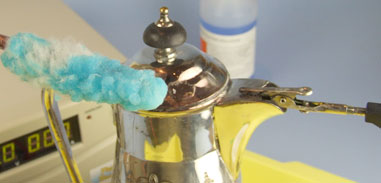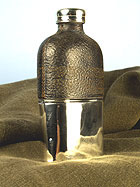Copper brush plating - an introduction and troubleshooting
Instructions on voltages and overcomming common problems
Copper, like gold, is one of the only two naturally occurring metals that is coloured. It is also relatively soft and therefore polishes easily and quickly. Below is some information about common applications of copper brush plating and a table showing practical information on voltages and how to solve some common problems you may encounter at the start.

Some applications for copper brush plating
Along with its relative softness, copper’s added tendency to deposit quite rapidly while plating makes it very useful to the brush plater. In the photo opposite of an antique hip flask, a layer of our Copper Brush Plating Solution was first plated and polished back to achieve a high shine. The polished copper was then silver plated and finished with MetaSeal. This approach is also economical, as you are polishing back copper, a much cheaper alternative to polishing back thickly deposited silver plating.
Our Copper Brush Plating Solution can also be used as the base for our White Bronze Mixer to create white bronze plating solution. This has a number of important applications; because it’s very tarnish resistant, it’s an alternative to silver and it provides a good barrier layer when plating gold on copper and its alloys.
As well as having important small scale functional applications, copper brush plating is often used on large scale projects such as the repair of dents and notches in large printing press rollers. Brush plating is the only truly economical way of solving the problem of worn printing rollers as the plating can be done in situ, avoiding the necessity of shutting down production for long periods to dismantle the printing equipment. You should use one of our Carbon Electrodes when brush plating copper and set your rectifier to 4 volts.

This antique hip flask was first copper brush plated to cover any scratches, then polished back and finally finished with a plated layer of silver using our Silver brush Plating Solution.
Copper brush plating; Troubleshooting
| Type of problem | Possible reason | What to do |
|---|---|---|
| No Plating taking place | 1. Incomplete electrical circuit or incorrect electrical polarity i.e. leads not in correct sockets.2. Surface not clean enough.3. Surface inactive because of thin filme of oxidisation which has formed on the underlying metal. | 1. Check all electrical connections and clean if necessary. Check the swab is fully saturated.2. Lightly polish by hand and clean thoroughly.3. Re-polish and clean. |
| Plating turning black, especially on the edges or corners of your work. | 1. Voltage too high. 2. Movement of swab over work too slow. |
1. Reduce voltage. 2. Move swab more rapidly over surface. |
| Plate peeling | Our Copper Brush Plating Solution does not stick to nickel or steel, so try to find out if the metal you’re plating is one of either of these metals. | If you want to go ahead with using our copper on nickel or steel you need to Gold Flash first which sticks to nickel and steel very efficiently. |
| Staining | 1. It is quite common to see staining as you move the swab to the other areas on the article you are plating. 2. Touching the work while you are plating. |
1. Make sure you keep brushing the swab over areas where you can see staining. Light staining can be removed after plating by rubbing with MPU 2. Copper is very touch sensitive so try to hold you work where it isn’t going to be plated. It might be worthwhile making a jig to hold the work for you while you are plating. |

Leave a Reply
You must be logged in to post a comment.